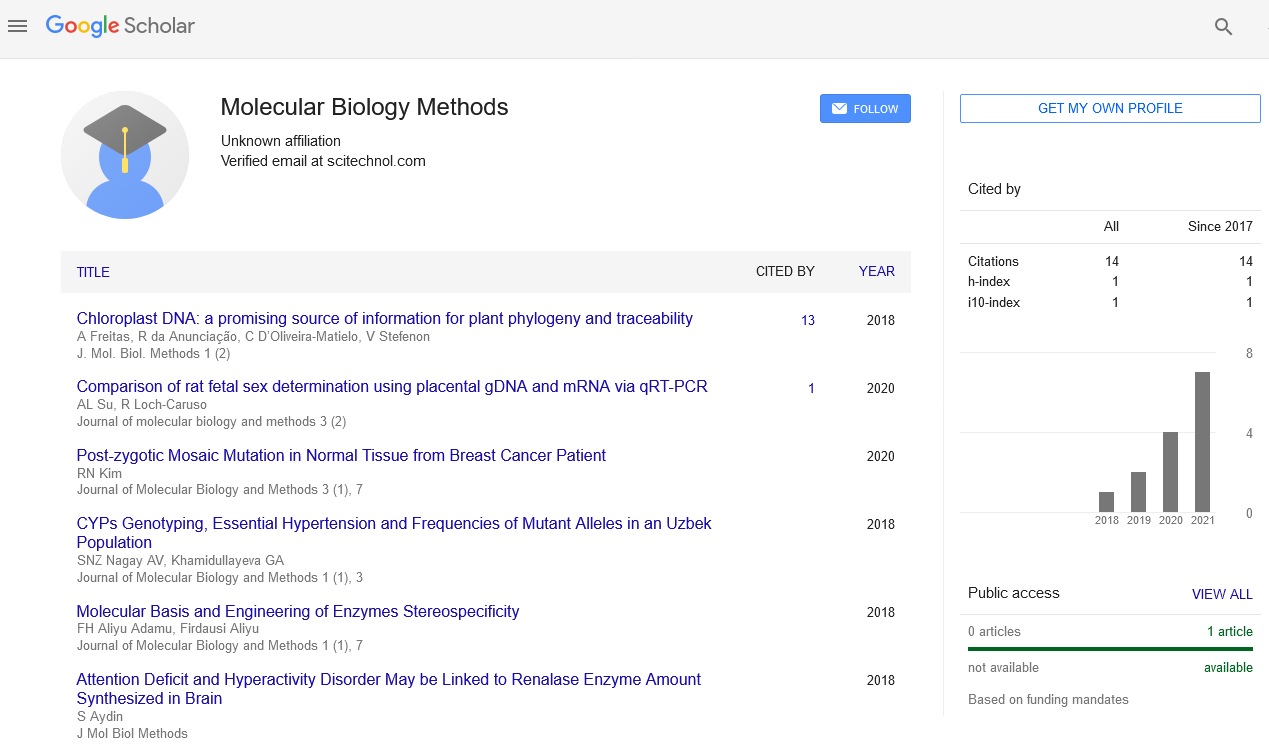Commentary, J Mol Biol Methods Vol: 7 Issue: 1
Cell Synthesis: A Comprehensive Overview
Jennifer Levye*
1Department of Biology, East Carolina University, Greenville, United States of America
*Corresponding Author: Jennifer Levye,
Department of Biology, East Carolina
University, Greenville, United States of America
E-mail: levyejennifer@unl.edu
Received date: 26 February, 2024, Manuscript No. JMBM-24-136908;
Editor assigned date: 29 February, 2024, PreQC No. JMBM-24-136908 (PQ);
Reviewed date: 14 March, 2024, QC No. JMBM-24-136908;
Revised date: 21 March, 2024, Manuscript No. JMBM-24-136908 (R);
Published date: 28 March, 2024, DOI: 10.4172/JMBM.1000148
Citation: Levye J (2024) Cell Synthesis: A Comprehensive Overview. J Mol Biol Methods 7:1.
Description
Cell synthesis, the intricate process by which cells replicate and proliferate, is fundamental to life. From single-celled organisms to complex multicellular organisms like humans, cell synthesis governs growth, repair, and reproduction. The cell cycle, consisting of interphase, mitosis, and cytokinesis, orchestrates the orderly progression of cell synthesis. During interphase, the cell grows, replicates its DNA, and prepares for division. Mitosis, the process of nuclear division, ensures that each daughter cell receives an identical set of chromosomes. Mitosis is subdivided into prophase, metaphase, anaphase, and telophase, each characterized by distinct events such as chromosome condensation, alignment at the metaphase plate, separation of sister chromatids, and reformation of nuclear envelopes. Cytokinesis, the division of the cytoplasm, completes the cell cycle, yielding two daughter cells.
DNA replication is a central aspect of cell synthesis, occurring during the S phase of interphase. This semiconservative process involves the unwinding of the DNA double helix, facilitated by enzymes such as helicase, and the synthesis of complementary strands by DNA polymerase. The replication forks formed move bidirectionally along the DNA molecule, ensuring accurate duplication of the genetic material. Various checkpoints, regulated by Cyclin- Dependent Kinases (CDKs) and checkpoint proteins monitor the fidelity of DNA replication and coordinate progression through the cell cycle.
Cell synthesis is tightly regulated by a complex network of signaling pathways and checkpoint mechanisms. Key regulators include cyclins, Cyclin-Dependent Kinases (CDKs), tumor suppressors (e.g., p53), and growth factors. Cyclins, whose levels oscillate throughout the cell cycle, bind to and activate specific CDKs, driving the progression from one phase to the next. Checkpoint mechanisms, such as the G1/S and G2/M checkpoints, ensure that cells only proceed through the cell cycle if conditions are favorable and DNA integrity is preserved. Dysregulation of these control mechanisms can lead to aberrant cell synthesis and contribute to diseases such as cancer.
During embryonic development, cell synthesis plays a crucial role in shaping the growing organism. Rapid cell proliferation generates the diverse cell types and tissues that comprise the body. As development progresses, cell synthesis becomes more regulated, with precise control over cell division and differentiation. Stem cells, with their unique ability to self-renew and differentiate into specialized cell types, are central players in this process. Understanding the molecular mechanisms that govern cell synthesis during development is essential for regenerative medicine and tissue engineering applications.
In adult organisms, cell synthesis maintains tissue homeostasis and facilitates tissue repair and regeneration. Tissues with high turnover rates, such as the epithelia lining the gut and skin, rely on continuous cell synthesis to replace damaged or senescent cells. Stem cells residing within these tissues serve as a reservoir for lost or damaged cells. In response to injury, various signaling pathways are activated to stimulate cell proliferation and tissue repair. Understanding the dynamics of cell synthesis in tissue homeostasis and repair is crucial for developing therapies for chronic wounds and degenerative diseases.
Cell synthesis is a complex and tightly regulated process essential for the growth, development, and maintenance of organisms. From the molecular mechanisms governing DNA replication to the orchestration of cell division and differentiation, cell synthesis encompasses a diverse array of biological phenomena. Understanding the intricacies of cell synthesis not only deepens our knowledge of fundamental biology but also holds promise for addressing various human diseases and advancing regenerative medicine. As we continue to unravel the mysteries of cell synthesis, we move closer to harnessing its potential for improving human health and well-being.
 Spanish
Spanish  Chinese
Chinese  Russian
Russian  German
German  French
French  Japanese
Japanese  Portuguese
Portuguese  Hindi
Hindi 